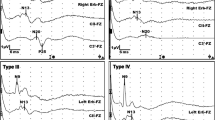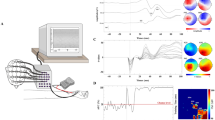Abstract
Objective
To directly compare the predictive powers of somatosensory evoked potentials (SEPs) to those of motor and pupillary responses.
Design and setting
Prospective clinical study in a paediatric intensive care unit.
Patients and participants
102 severely brain-injured children less than 15 years of age.
Measurements and results
SEPs and motor and pupillary responses were serially recorded during the first 9 days after admission. Initial, last and those tests performed on or after day 2 were analysed. Outcome was assessed 5 years after injury. SEPs had equal or superior predictive statistics and ROC curves compared to the other tests with few exceptions. Pupillary responses had higher sensitivity for favourable outcome prediction while for unfavourable outcome prediction the last motor responses had higher sensitivity, and the last pupillary responses had slightly higher specificity. Combining SEPs and motor responses provided the best combination for predicting unfavourable outcome.
Conclusions
SEPs are the best overall predictor of outcome while motor and pupillary responses have advantages in some specific areas. The routine use of SEPs should be considered in the prediction of outcome of severely brain-injured patients.


Similar content being viewed by others
References
Carter BG, Butt W (2001) A review of the use of somatosensory evoked potentials (SEPs) in the prediction of outcome after severe brain injury. Crit Care Med 29:178–186
Zandbergen EGJ, de Haan RJ, Stoutenbeek CP, Koelman JHTM, Hijdra A (1998) Systematic review of early prediction of poor outcome in anoxic-ischaemic coma. Lancet 352:1808–1812
Carter BG, Taylor A, Butt W (1999) Severe brain injury in children: long-term outcome and its prediction using somatosensory evoked potentials (SEPs). Intensive Care Med 25:722–728
Jennett B, Bond M (1975) Assessment of outcome after severe brain damage. Lancet I:480–484
Altman DG (1991) In: Practical statistics for medical research. Chapman and Hall. Melbourne
Carter BG, Butt W (2005) Are somatosensory evoked potentials the best predictor of outcome after severe brain injury? A systematic review. Intensive Care Med (http://dx.doi.org/10.1007/s00134-005-2633-1, in press)
Anderson DC, Bundlie S, Rockswold GL (1984) Multimodality evoked potentials in closed head trauma. Arch Neurol 41:369–374
Bassetti C, Bomio F, Mathis J, Hess CW (1996) Early prognosis in coma after cardiac arrest: a prospective clinical, electrophysiological, and biochemical study of 60 patients. J Neurol Neurosurg Psychiatry 61:610–615
Cant BR, Hume AL, Judson JA, Shaw NA (1986) The assessment of severe head injury by short-latency somatosensory and brain-stem auditory evoked potentials. Electroencephalogr Clin Neurophysiol 65:188–195
Nakabayashi M, Kurokawa A, Yamamoto Y (2001) Immediate prediction of recovery of consciousness after cardiac arrest. Intensive Care Med 27:1210–1214
Ying Z, Schmid UD, Schmid J, Hess CW (1992) Motor and somatosensory evoked potentials in coma: analysis and relation to clinical status and outcome. J Neurol Neurosurg Psychiatry 55:470–474
Beca J, Cox PN, Taylor MJ, Bohn D, Butt W, Logan WJ, Rutka JT, Barker G (1995) Somatosensory evoked potentials for prediction of outcome in acute severe brain injury. J Pediatr 126:44–49
Chen R, Bolton CF, Young GB (1996) Prediction of outcome in patients with anoxic coma: a clinical and electrophysiologic study. Crit Care Med 24:672–678
Kent DL, Larson EB (1992) Disease, level of impact, and quality of research methods. Three dimensions of clinical efficacy assessment applied to magnetic resonance imaging. Invest Radiol 27:245–254
Cochrane Methods Group on Systematic Review of Screening and Diagnostic Tests (1996) Recommended method.http://www.cochrane.org/cochrane/sadtdoc1.htm, accessed 14 July 2002
Glasiou P, Irwig L (1998) Meta-analyses of diagnostic tests. In: Armitage P, Colton T (eds) Encyclopaedia of biostatistics. Wiley, West Sussex
Madl C, Grimm G, Kramer L, Yeganehfar W, Sterz F, Schneider B, Kranz A, Schneeweiss B, Lenz K (1993) Early prediction of individual outcome after cardiopulmonary resuscitation. Lancet 341:855–858
Nuwer MR, Aminoff M, Desmedt J, Eisen AA, Goodin D, Matsuoka S, Mauguere F, Shibasaki H, Sutherling W, Vibert JF (1994) IFCN recommended standards for short latency somatosensory evoked potentials. Report of an IFCN committee. Electroencepalogr Clin Neurophysiol 91:6–11
Lutschg J, Pfenninger J, Ludin HP, Vassella F (1983) Brain-stem auditory evoked potentials and early somatosensory evoked potentials in neurointensively treated comatose children. Am J Dis Child 137:421–426
Sutton LN, Frewen T, Marsh R, Jaggi J, Bruce DA (1982) The effects of deep barbiturate coma on multimodality evoked potentials. J Neurosurg 57:178–185
McPherson RW, Sell B, Traystman RJ (1986) Effects of thiopental, fentanyl, and etomidate on upper extremity somatosensory evoked potentials in humans. Anesthesiology 65:584–589
Koht A, Schutz W, Schmidt G, Schramm J, Watanabe E (1988) Effects of etomidate, midazolam and thiopentone on median nerve somatosensory evoked potentials and the additive effects of fentanyl and nitrous oxide. Anesth Analg 67:435–441
Lauer K, Munshi C, Larson S (1994) The effect of midazolam on median nerve somatosensory evoked potentials. J Clin Monit 10:181–184
Mauguiere F, Allison T, Babiloni C, Buehner H, Eisen AA, Goodin DS, Jones SJ, Kakigi R, Matsuoka S, Nuwer M, Rossini PM, Shihasaki H (1999) Somatosensory evoked potentials. Electroencephalogr Clin Neurophysiol Suppl 52:79–90
Zweig MH, Campbell G (1993) Receiver-operating characteristic (ROC) plots: a fundamental evaluation tool in clinical medicine. Clin Chem 39:561–577
Biggerstaff BJ (2000) Comparing diagnostic tests: a simple graphic using likelihood ratios. Stat Med 19:649–663
Edgren E, Hedstrand V, Kelsey S, Sutton-Tyrrell K, Safar P, BRCTI Study Group (1994) Assessment of neurological prognosis in comatose survivors of cardiac arrest. Lancet 343:1055–1059
Attia J, Cook DJ (1998) Prognosis in anoxic and traumatic coma. Crit Care Clin 14:497–511
Author information
Authors and Affiliations
Corresponding author
Rights and permissions
About this article
Cite this article
Carter, B.G., Butt, W. A prospective study of outcome predictors after severe brain injury in children. Intensive Care Med 31, 840–845 (2005). https://doi.org/10.1007/s00134-005-2634-0
Received:
Accepted:
Published:
Issue Date:
DOI: https://doi.org/10.1007/s00134-005-2634-0




